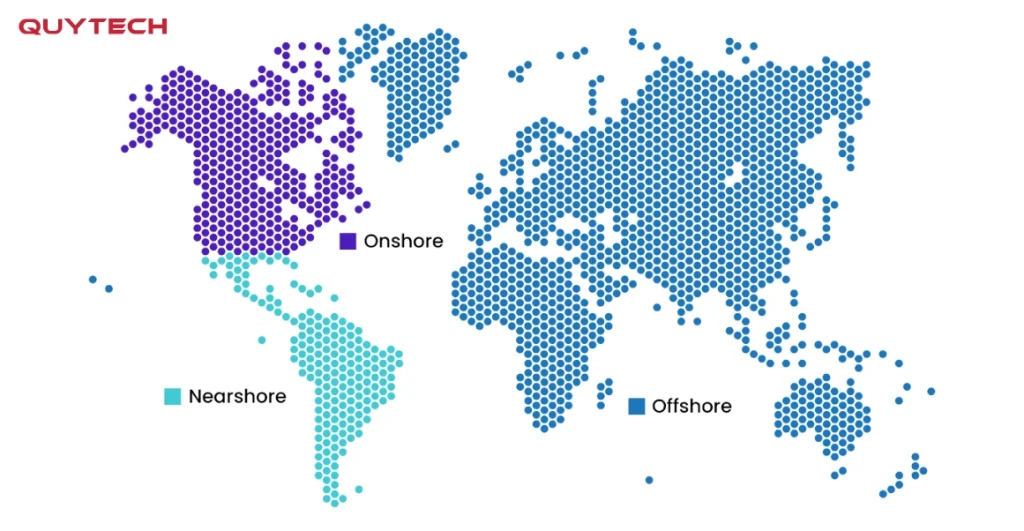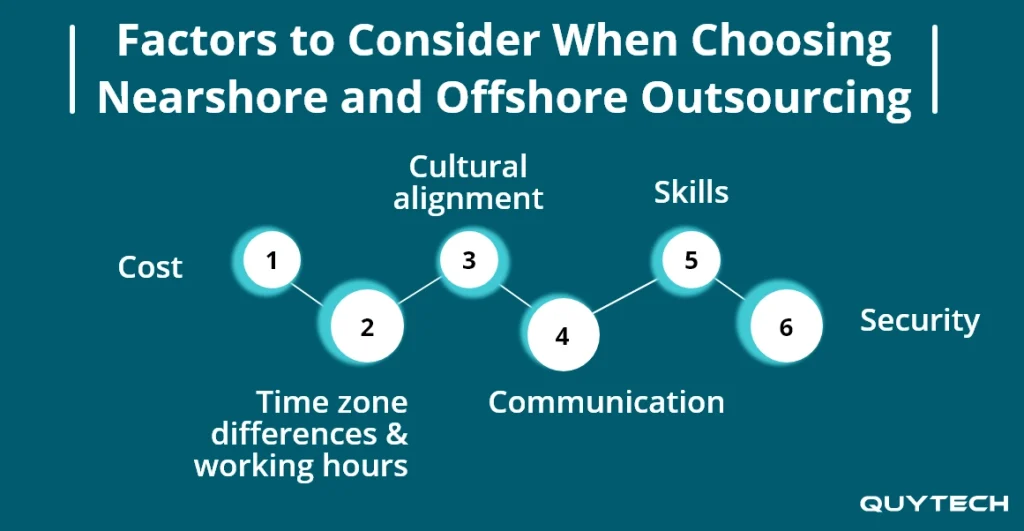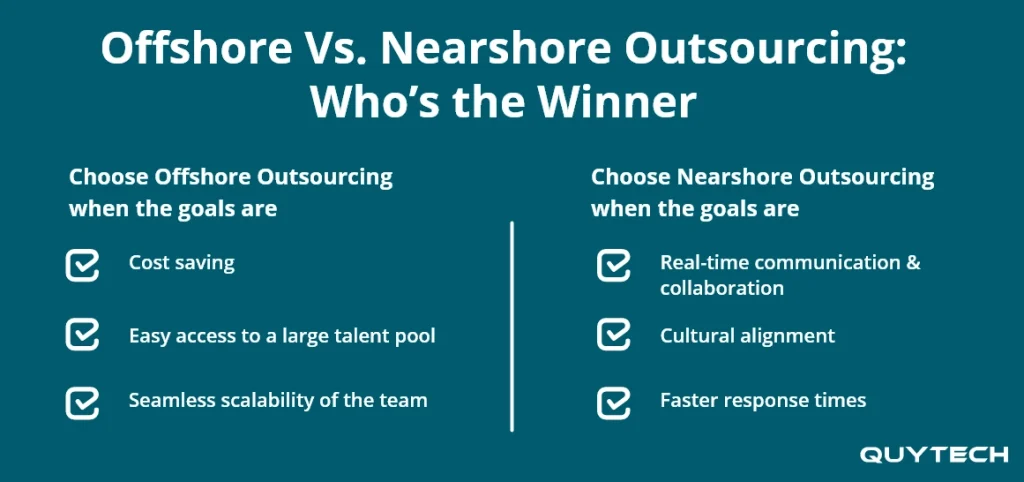You want to develop software or a mobile application for your business, and for that, you need a software development team. Now, hiring a full-fledged development team, including designers, developers (backend and frontend), and testers, is not a good idea, especially if you don’t need to create just one software/app.
Outsourcing your project is indeed a wise decision in such a scenario. It will not only serve your purpose of building an app but also be light on your pocket. Now, upon searching for project outsourcing, you get bombarded with different outsourcing models, such as offshore, onshore, and nearshore.
Not just you, but anyone can get confused at this moment. The struggle of browsing offshore vs nearshore outsourcing continues because you want to know the differences, pros & cons, and other aspects of these two models.
Let’s make this easy for you by providing you with a detailed comparison between nearshore and offshore outsourcing. As the name suggests, offshore outsourcing is choosing a technology partner in distant countries that have a different time zone.
Nearshore outsourcing is partnering with a technology company in nearby countries with the same time zone. Lastly, onshore outsourcing is hiring resources from a company within your country. Read on to know more about it:
Offshore Outsourcing Vs. Nearshore Outsourcing: Definition
A one-liner definition (mentioned in the blog’s introduction) of nearshore outsourcing and offshore outsourcing might give you an idea of both these outsourcing models. However, before you pick one for your project, let’s take a look at these examples where we have created real-world scenarios for quick understanding:
What is Offshore Outsourcing
A company in America is building a mobile app. It has a full-fledged development team but doesn’t have DevOps engineers to accelerate the development or AI professionals to bring intelligence and automation to the app. Instead of hiring AI engineers or DevOps professionals within the US (which would definitely cost high), the company looks for offshore outsourcing or IT staff augmentation services in India or similar countries.

What is Nearshore Outsourcing
The same American company choosing to hire AI professionals or DevOps engineers in Mexico or Colombia is a perfect example of nearshore outsourcing. The cost would be a little higher, but the team is available for communication or quick calls in the same time zone.
Both offshore and nearshore can work for your company, depending on your specific project requirements and budget constraints.
Nearshore vs Offshore Outsourcing: Working Process
Let’s understand the difference between the nearshore and offshore outsourcing processes:
Nearshore Outsourcing: How It Works
- Find out your project needs.
- Search for a reliable outsourcing service provider in your nearby country.
- Select the right one and set up real-time communication and project management tools.
- Begin your project; their team will work in the same hours as you.
- Get your project done. You may expand collaboration, if needed.
Offshore Outsourcing: How It Works
- Define your project requirements or tasks for which you need outsourcing services.
- Select an experienced technology partner from a distant country.
- Set up a communication framework to ensure the team is just a call away.
- The team will perform assigned tasks.
- Review deliverables.
Similar Read: How to Set up a (GCC) Global Capability Center Successfully?
Offshore Vs. Nearshore Outsourcing: A Tabular View of the Differences
Quickly understand the difference between offshore and nearshore outsourcing with this table:
| Aspects | Offshore Outsourcing | Nearshore Outsourcing |
| Location | Project outsourcing is often done to distant countries and different continents. | The project is outsourced to a technology partner in a nearby country. |
| Time Zone | Time zone differences are significant. | Time zones are similar. |
| Cost | Usually, lower labor costs | Slightly higher costs than offshore |
| Communication | Communication and collaboration, especially in real-time, can be a challenge due to differences in time zone and language. | Easier and real-time communication due to similar time zones. |
| Cultural Alignment | It may need a little effort for the outsourcing team to understand your work culture and practices. | The chances of misunderstandings are less due to aligned cultures. |
| Travel and Oversight | Travel, if required, is longer and expensive. | The team you hire can travel to your location for project reviews. The distance is usually short. |
| Talent Pool | This type of outsourcing model offers access to a large global talent pool. | Smaller talent pool as compared to offshore outsourcing. |
| Project Turnaround | The team that works remotely on your project can continue working overnight in some cases. | Faster real-time collaboration ensures quicker feedback cycles. |
Take a look at: IT Staff Augmentation Trends and Future Predictions
Difference Between Nearshore and Offshore Outsourcing: Detailed Comparison
A table may provide you with an idea of the key differences between nearshore and offshore outsourcing. However, for a detailed comparison, it is important that you understand every difference thoroughly. This section will provide you with that:
Location
In offshore outsourcing, you can partner with companies or technology partners from distant countries. These countries are usually located on different continents.
Nearshore outsourcing involves finding a technology partner in neighboring or nearby countries to hire resources. Collaboration and real-time communication are easier due to similar time zones.
Time Zone and Communication
In offshore outsourcing, the time zone is different, which could be a problem in real-time communication. It can also impact project planning; however, businesses can ensure 24*7 working on their project.
In nearshore outsourcing, the entire project team (in-house and outsourced) works in the same time zone. It makes real-time communication and collaboration easier. Besides, getting feedback during the project is also quick.
Cost
In offshore outsourcing, the cost is lower. When you outsource your project or specific tasks to a technology partner in countries like India, the Philippines, or Vietnam, you can get access to highly skilled and certified professionals at a low cost.
In nearshore outsourcing, the cost of outsourcing the project or hiring resources is a little higher. However, it is still less than hiring resources within your own country (onshore).
Communication
In offshore outsourcing, communication is not real-time. The company needs to set up tools or platforms to ensure the given tasks are being completed on time and deliver feedback on the completed tasks.
In nearshore outsourcing, companies can connect and communicate with nearshore partners at any time, as their work hours are the same.
Cultural & Language Alignment
In offshore outsourcing, there could be cultural differences as the work culture in different countries is different. There are countries where one may also find language barriers (provided English is not the preferred language they want to communicate in).
In nearshore outsourcing, work culture and language fluency are more or less the same. The chances of facing struggles with these two aspects are very less.
Talent Pool
In offshore outsourcing, companies can access a global talent pool. Whether they want to hire AI developers or any other technology specialist, they can get so many options.
Nearshore outsourcing also offers access to skilled talent, but the talent pool is comparatively smaller.
Project Turnaround
Companies generally choose Offshore outsourcing for large-scale projects where direct monitoring and real-time communication are not a priority. Project turnaround time is generally high.
In nearshore outsourcing, the project turnaround time is shorter. Thanks to real-time collaboration and quicker feedback cycles.
Security and Compliance
In offshore outsourcing, ensuring security and compliance requires implementing additional measures. Data protection and adherence to international regulations are a must.
In nearshore outsourcing, companies or nearshore partners are often aligned with or aware of regulations and standards. It makes compliance management easier.
Management and Oversight
In offshore outsourcing, on-site visits and direct supervision are not practical or feasible due to long distances. Companies can only communicate digitally.
In nearshore outsourcing, project management and monitoring team’s performance is easier as the management teams can also travel to evaluate or review.
Project Complexity and Scope
Offshore outsourcing is suitable for large-scale projects where operations or tasks can be broken down and executed without any hassle.
Nearshore outsourcing is a perfect choice for companies that require hiring teams for medium-to-complex projects.
You may like to read: How to Hire Offshore Development Team? A Complete Guide For Businesses
Pros and Cons of Nearshore and Offshore Outsourcing Models
Now that you know enough about nearshoring vs offshoring, it is time to look at their advantages and disadvantages:
Advantages and Disadvantages of the Offshore Outsourcing Model
| Pros | Cons |
| The cost is significantly lower due to the low labor cost. | Time zone differences lead to communication gaps and delays. |
| It offers access to a large pool of specialized professionals. | Misunderstandings may occur due to differences in work cultures and practices. |
| It has a 24*7 work cycle. | It is difficult to have direct oversight over the team. |
Advantages and Disadvantages of the Offshore Outsourcing Model
| Pros | Cons |
| It offers real-time communication and collaboration. Thanks to the similar time zone and working hours. | The cost is slightly higher than offshore but less than onshore. |
| Work culture in most companies in nearby countries is more or less the same. | Companies get access to a limited or smaller talent pool. |
| The short distance between the company and its technology partner makes on-site visits possible. | Less flexibility in scaling teams. |
Interesting Read: Top 06 Benefits of IT Staff Augmentation You Should Know
Factors to Consider When Choosing Nearshore and Offshore Outsourcing

Whether you choose nearshore or offshore outsourcing, what you need to keep in mind are these factors:
- Cost: Make sure you check the cost of hiring resources thoroughly. Ensure there is no hidden cost, related to travel, communication, and more.
- Time zone differences and working hours: Check both these aspects before you partner with an offshore or nearshore company.
- Cultural alignment: Make sure the company understands your business culture and ethics.
- Communication: Whether you choose an offshore or nearshore outsourcing company, ensure it offers clear communication and uses transparent communication tools.
- Skills: Don’t forget to evaluate the skills of the resources or professionals you want to hire from a nearshore or offshore company.
- Security: Check the security techniques and methods that the company implements to ensure data security and privacy. Make sure they are conversant with the regulations and standards of your country.
Also Read: How to Hire Top Software Developers?
Challenges Associated with Offshore and Nearshore Outsourcing
Before you select offshore outsourcing or nearshore outsourcing, it is important to understand the key challenges associated with both of them.
| Offshore Outsourcing | Nearshore Outsourcing |
| Communication delays | Slightly higher costs |
| Cultural misalignment | Smaller talent pool |
| Costly travel and Limited project oversight | Fewer chances for 24/7 operations |
| Security and compliance concerns | High competition for top talent within the region |
| Longer project turnaround | Limited scalability for large projects |
You might be interested in: How to Set up an Offshore Development Center in India? A Comprehensive Guide
Offshore Vs. Nearshore Outsourcing: Who’s the Winner

The answer to this question clearly depends on your specific project requirements, business goals, and budget constraints.
Choose Offshore Outsourcing when the goals are:
- Cost saving
- Easy access to a large talent pool
- Seamless scalability of the team
Remember, it is suitable for large-scale projects and when real-time collaboration and quick project turnaround time are not needed.
Choose Nearshore Outsourcing when the goals are:
- Real-time communication and collaboration
- Cultural alignment
- Faster response times
Nearshore outsourcing is perfect for projects where agile development, frequent collaboration, and direct management and oversight are top priorities.
How Quytech Can Help
Whether you are looking for offshore or nearshore outsourcing, choosing the right technology partner for these services is highly important. At Quytech, we can help you with hiring the right resources with our cutting-edge offshore software development services.
With us, you can also establish a full-fledged offshore development center in India. We have dedicated development teams with expertise in DevOps, AI, blockchain, ML, Generative AI, and other technologies. Moreover, we offer flexible models so that you can scale your project development teams without any hassle. Transparency, speed, and commitment to quality are our USPs.
Conclusion
The blog “offshore vs. nearshore outsourcing, clearly explains all the differences between these two models. Each model has its own benefits in terms of cost, time, communication, and other aspects. Offshore is about hiring resources from a country where the time zone is different, whereas nearshore is hiring resources from a nearby country where the time zone is the same.
For your project, you can choose any of these two models (since you have read this comparison blog of offshore and nearshore). You can also go for a hybrid approach and use the advantages of both worlds to maximize efficiency, access ga lobal talent pool, ensure real-time collaboration and communication, and keep the project cost low.
Frequently Asked Questions About Offshore Versus Nearshore Outsourcing
Offshore outsourcing means hiring teams from countries across different continents. The main goal is to access specialized skills within a budget. The hired team works in a different time zone.
Nearshore outsourcing means hiring software developers, AI engineers, and other experts from a company in a nearby country with a similar time zone. It is a little expensive than offshore outsourcing.
Offshore outsourcing is more cost-effective than nearshore outsourcing. That’s because the cost of hiring resources is less in countries like India or Vietnam. But with offshore outsourcing, you may not get real-time communication and collaboration with the team.
If you have a medium-to-complex project that requires frequent communication, agile development, and close monitoring, then choose nearshore outsourcing. Offshore outsourcing is suitable for large-scale projects where different tasks can be categorized and assigned to be done by hiring remote teams.
Yes, using a hybrid approach can make this possible. Companies can hire teams or professionals for large-scale projects using offshore outsourcing. For projects involving agile tasks and real-time collaboration can be done by hiring professionals with a nearshore outsourcing model.



